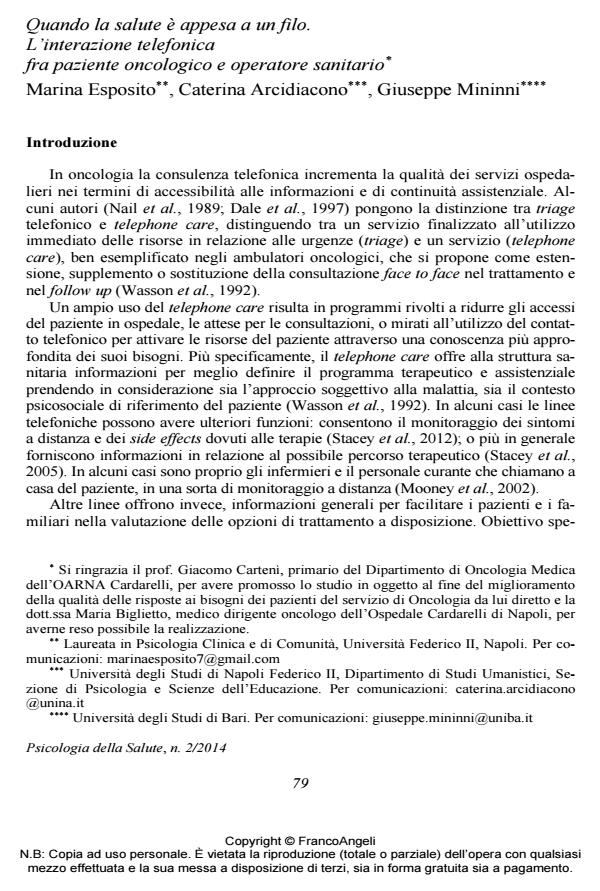Health under the telephone wire. Telephonic interaction between oncological patients and health workers
Journal title PSICOLOGIA DELLA SALUTE
Author/s Marina Esposito, Caterina Arcidiacono, Giuseppe Mininni
Publishing Year 2014 Issue 2014/2
Language Italian Pages 17 P. 79-95 File size 99 KB
DOI 10.3280/PDS2014-002006
DOI is like a bar code for intellectual property: to have more infomation
click here
Below, you can see the article first page
If you want to buy this article in PDF format, you can do it, following the instructions to buy download credits

FrancoAngeli is member of Publishers International Linking Association, Inc (PILA), a not-for-profit association which run the CrossRef service enabling links to and from online scholarly content.
The psycho-oncological literature highlighted the importance of temporal continuity and professional competence when it comes to the relationship between patients affected by cancer and health workers who attend to them. This research has analyzed, from a cultural and community psychology perspective as well as a psycho-semiotic perspective, some telephonic interactions that have taken place on a telephone counselling service, which is geared to patients undergoing home-based chemotherapeutic treatments. To this end we did an ethno-psychological observation (Freda, 2011; Angrosino, 2007) of the hospital department and have carried out 54 telephonic consultations subsequently analysed by means of the dia-textual analysis (Mininni, 2003). The analysis focus on the delegitimation felt by the health workers when it comes to taking charge of the patients; these feelings are linked to the ambivalence showed by the physicians with regard to the delegation of the patients themselves. By setting up a collaboration between the health workers who deal with the patients and the health personnel who set the therapeutic protocol it is possible to build up more professional responsibility as well as efficacy and efficiency for the whole institution while re-defining the quality of the service this provides.
Keywords: Diatextual analysis, telephonic health consultation, health services implementation, homebased chemiotherapeutic treatments.
- Una vita senza vita. Pazienti con patologia oncologica mammaria in follow up Florencia Gonzalez Leone, Immacolata Di Napoli, Daniela Barberio, Francesco De Falco, Caterina Arcidiacono, in PSICOLOGIA DELLA SALUTE 3/2019 pp.54
DOI: 10.3280/PDS2019-003004
Marina Esposito, Caterina Arcidiacono, Giuseppe Mininni, Quando la salute è appesa a un filo. L’interazione telefonica fra paziente oncologico e operatore sanitario in "PSICOLOGIA DELLA SALUTE" 2/2014, pp 79-95, DOI: 10.3280/PDS2014-002006